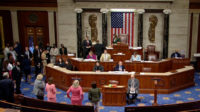New York state is advancing its plan to expand the Albany NanoTech Complex semiconductor research and development center as part of an effort to land federal designation—and funding—as a hub under the National Semiconductor Technology Center.
The state will put $1 billion toward the costs of construction and equipment for the expansion, Gov. Kathy Hochul announced Dec. 11.
The New York Center for Research, Economic Advancement, Technology, Engineering and Science Corp. (NY CREATES), the state agency that operates the NanoTech complex at the University at Albany, selected a joint venture of Gilbane Building Co. and DPS Advanced Technology Group Inc. in August as the design-build contractor for the expansion, known as NanoFab Reflection. Design and construction for the project are expected to cost $410 million, NY CREATES records show.
Construction would last about two years and will involve between 500 and 600 union construction jobs at peak, according to Hochul’s office.
The scope of work for NanoFab Reflection is planned to include construction of a building with a 50,000-sq-ft clean room plus supporting buildings and a parking structure, according to NY CREATES. Gilbane has launched a page for interested subcontractors to become prequalified and a list of anticipated bid packages.
The newly announced funding will also go toward the purchase of advanced equipment for the facility, namely an ASML EXE:5200 High NA EUV scanner. According to IBM, which is one of several tech companies that have partnered with the state on the complex, the machine could be used to develop new semiconductor chips that are a fraction of the size of current chips and more efficient. This would be the first publicly owned R&D center in North America with such equipment.
“The new high NA EUV center at Albany NanoTech will secure a strong pipeline for semiconductor innovation, keeping New York state at the center of semiconductor expertise, accelerating the growth of the global chip industry and helping to meet manufacturing demand for new technologies such as generative AI,” said Arvind Krishna, CEO and chair of IBM, in a statement.
The state is hoping to position the NanoTech complex as an anchor hub under the National Semiconductor Technology Center, formed by last year’s CHIPS and Science Act. The site’s selection could enable it to receive as much as $11 billion in federal funding for research from the law.
In addition to IBM, New York’s efforts to draw the chip sectors have brought companies including Micron, Applied Materials and Tokyo Electron to the Albany site. Micron is also planning a $100-million chip fabrication plant in the Syracuse area.
“When this is all up and running here, companies from around the world are going to flock to this area,” Hochul said at an event announcing the funding. “They're already starting.”






Post a comment to this article
Report Abusive Comment